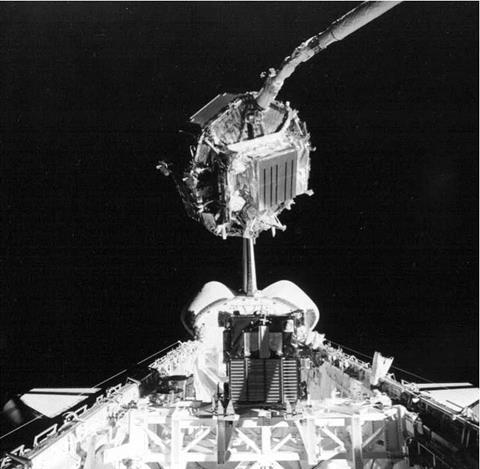STS-72
 1996-001A 11 January 1996
1996-001A 11 January 1996
Pad 39B, Kennedy Space Center, Florida 20 January 1996
Runway 15, Shuttle Landing Facility, KSC, Florida OV-105 Endeavour/ET-75/SRB BI-077/SSME #1 2028; #2 2039; #3 2036 8 days 22 hrs 1 min 47 sec Endeavour
Retrieval of Japanese Space Flyer Unit; deployment and retrieval of OAST-Flyer; EDFT-03
Flight Crew
DUFFY, Brian, 42, USAF, commander, 3rd mission Previous missions: STS-45 (1992); STS-57 (1993)
JETT Jr., Brent Ward, 37, USN, pilot
CHIAO, Leroy, 35, civilian, mission specialist 1, 2nd mission
Previous mission: STS-65 (1994)
SCOTT, Winston Elliott, 45, USN, mission specialist 2 WAKATA, Koichi, 32, civilian, Japanese mission specialist 3 BARRY, Daniel Thomas, 42, civilian, mission specialist 4
Flight Log
The launch of STS-72 was delayed for 23 minutes due both to problems with ground sites and the need to avoid a potential collision with an item of space debris. On FD 3, Japanese MS Wakata used the RMS to grasp the Japanese Space Flyer Unit (SFU), which had originally been launched in March 1995 aboard an H-2 rocket from the Tanegashima Space Centre in Japan. Over a ten-month period, more than a dozen onboard instruments and experiments had been operating in a research programme that encompassed materials and biological science. Prior to grappling the unit with the RMS, the twin solar arrays had to be jettisoned after it was found that they were not correctly retracted.
The next day, the Office of Aeronautics and Space Technology Flyer (OAST – Flyer) was deployed, again by Wakata using the RMS, on an independent two-day flight that extended to approximately 72 km from Endeavour. Attached to the SPARTAN platform were four experiments that investigated spacecraft contamination, global positioning technology, laser ordnance devices and an amateur radio package. The flyer was retrieved on FD 6. In addition to the deployment and retrieval operations, the crew had a programme of payload bay and mid-deck secondary
|
The Japanese Space Flyer Unit (SFU) is retrieved using the Shuttle’s RMS. The yet-to-be – deployed OAST Flyer satellite is seen in the payload bay at bottom centre |
experiments to conduct, which mainly consisted of studies in ozone concentrations in the atmosphere, a laser to accurately measure the distance between the Earth’s surface and the orbiter, and a range of biological and biomedical experiments.
The crew also completed two EVAs as part of the EDFT programme of preparation for extensive EVA activities during ISS construction. During the first EVA (15 Jan, 6 hours 9 minutes), astronauts Chiao (EV1) and Barry (EV2) evaluated a new portable work platform and the Rigid Umbilical Structure, which was being developed as a possible retention device for ISS fluid and electrical lines. During the second EVA (17 Jan, 6 hours 54 minutes), this time conducted by Chiao and Scott (EV3), the portable work platform was again evaluated and the astronauts also tested the design of a utility box, another item under development for ISS, which would hold avionics and fluid line connections. During the EVA, Scott tested his suit in severe cold temperatures of up to —75°C, to find out whether the revised design would keep him warm during the test. In fact, the 35-minute test resulted in temperatures of — 122°C being recorded, providing a tough test of the suit’s extremities (fingers and feet) and coolant loop bypass system. Scott reported that he was aware of the low temperatures but remained comfortable and though had he been working rather than staying still, he determined that he would have felt warmer in either situation.
Milestones
185th manned space flight
104th US manned space flight
74th Shuttle mission
10th flight of Endeavour
33rd US and 60th flight with EVA operations
3rd EDFT exercise











